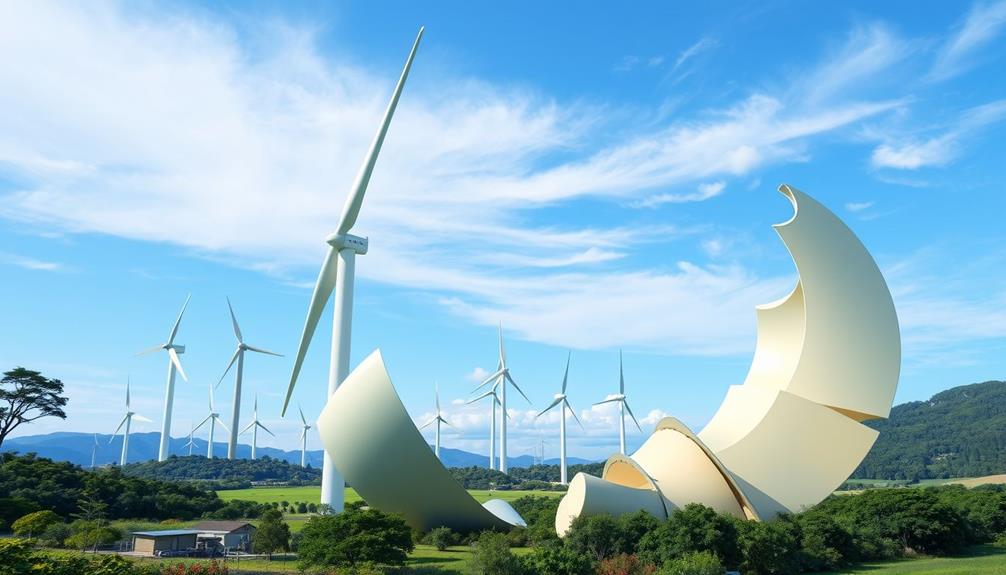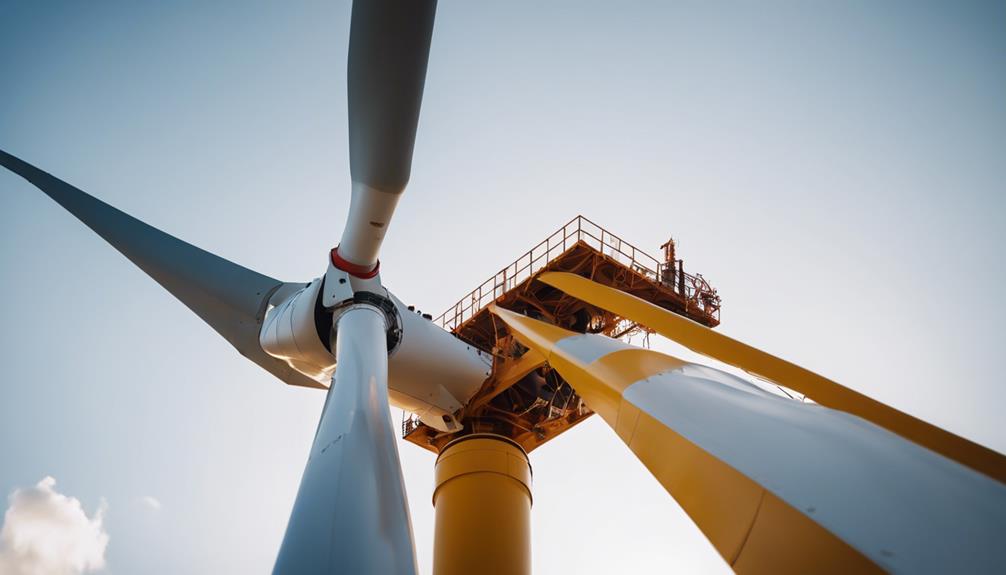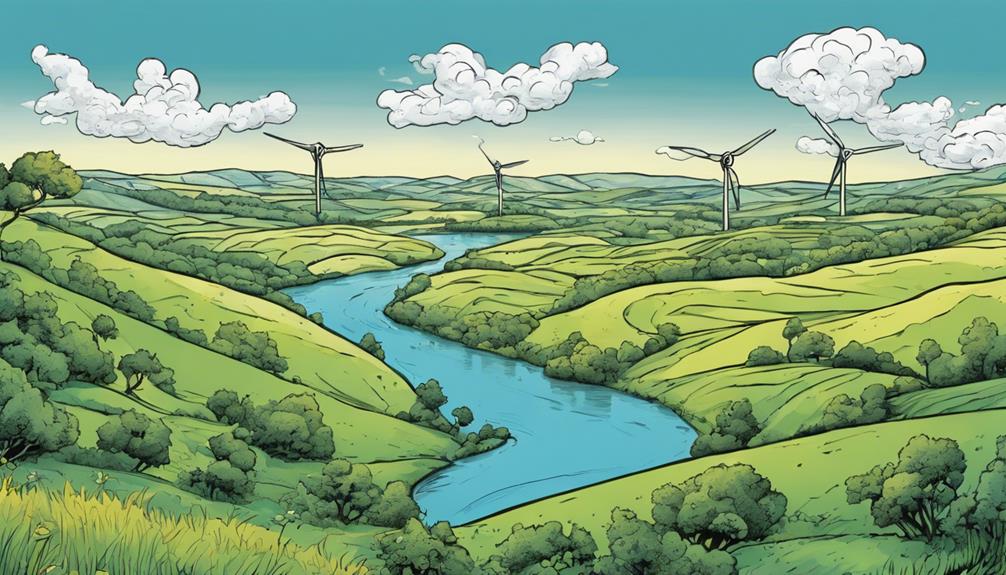Wind turbines are getting impressively large. In 2023, the average hub height is around 103.4 meters (339 feet), while rotor diameters exceed 133.8 meters (438 feet). We've seen a dramatic increase over the years, with new models reaching capacities of 3.4 megawatts or more. Offshore turbines are even taller, expected to reach 150 meters (500 feet) by 2035. These advancements not only enhance energy capture but also create transportation challenges. It's fascinating to see how technology is evolving to keep pace with these giants of renewable energy, and there's more to uncover about the future of wind turbines.
Key Takeaways
- The average hub height of U.S. land-based wind turbines reached 103.4 meters (339 feet) in 2023, a significant increase over the past two decades.
- Rotor diameters for newly installed turbines surpassed 133.8 meters (438 feet) in 2023, marking a 670% growth since 1998-1999.
- Offshore wind turbines are projected to reach hub heights of 150 meters (500 feet) by 2035, enhancing energy capture.
- The average capacity of newly installed U.S. wind turbines is now 3.4 megawatts (MW), a 375% increase since 1998-1999.
- Larger turbine designs face transportation challenges due to size, prompting innovations for more efficient delivery methods.
Hub Height Trends

In recent years, the average hub height of utility-scale land-based wind turbines has soared by 83% since 1998-1999, hitting 103.4 meters (about 339 feet) in 2023. This increase in hub height allows for larger turbines to capture stronger winds at higher altitudes, which greatly boosts electricity production.
As organizations embrace design thinking principles, they can enhance innovation in wind turbine technology, leading to more efficient designs. You might notice that the majority of turbines exceeding 100 meters in hub height are found in the Midwest and Northeast regions of the United States. These areas experience greater wind shear, making them ideal locations for taller turbines.
As technology continues to advance, you can expect this trend toward larger hub heights to persist. Offshore wind turbines are also set to follow suit, with projections estimating a rise from 100 meters (330 feet) in 2016 to an impressive 150 meters (500 feet) by 2035.
Taller turbines not only enhance efficiency, but they also optimize energy capture, contributing to more sustainable energy solutions. So, as you observe the changing landscape of wind energy, remember that these trends in hub height are a vital part of maximizing the potential of wind power.
Rotor Diameter Evolution

Driving innovation in wind energy, the rotor diameter of newly installed U.S. wind turbines has seen remarkable growth, exceeding an average of 133.8 meters (about 438 feet) in 2023. This represents a significant leap from previous years, where the landscape of wind turbines was quite different. Back in 2013, there were no turbines with rotor diameters larger than 115 meters (380 feet). By 2023, an impressive 98% of new installations featured these larger rotors, showcasing the evolution in design and technology.
The increase in rotor diameter has allowed for a staggering 670% growth in rotor swept areas since 1998-1999, enabling turbines to capture more wind energy effectively. Larger rotor diameters mean a greater swept area, which directly correlates to higher electricity production.
Here's a quick look at rotor diameter evolution:
| Year | Average Rotor Diameter | % of Turbines > 115m |
|---|---|---|
| 2013 | < 115m | 0% |
| 2018 | 120m | 45% |
| 2023 | 133.8m | 98% |
This trend reflects the demand for efficient energy generation and the advancements in wind turbine technology.
Nameplate Capacity Growth

The surge in nameplate capacity for wind turbines underscores a pivotal shift in wind energy efficiency. In 2023, the average capacity of newly installed U.S. wind turbines hit 3.4 megawatts (MW), a 5% increase from the previous year and a staggering 375% rise since 1998-1999.
This trend shows no signs of slowing down, with a growing number of turbines now boasting capacities of 3.5 MW or larger. Larger blades capture more wind energy that contribute to enhanced energy generation, which is essential for meeting our renewable energy goals.
Here's why this growth matters:
- Fewer Turbines Needed: As turbine capacity increases, you need fewer turbines to generate the same amount of electricity.
- Cost Efficiency: Fewer turbines mean lower overall costs for wind energy production.
- Technological Advancements: Ongoing investments in turbine technology and design have driven these capacity increases.
- Enhanced Energy Generation: With larger turbine blades, wind energy generation becomes more efficient.
As the nameplate capacity continues to grow, the landscape of wind energy is changing for the better, ensuring a more sustainable future.
Your understanding of these advancements highlights the significance of wind energy in our quest for renewable resources.
Transportation Challenges

As wind turbine sizes grow, transportation challenges become more pronounced. The increasing length of turbine blades means they can't be folded, which restricts the routes you can take and the turning radii needed for delivery. Many turbine tower diameters now exceed the clearance of bridges and highway overpasses, complicating logistics even further.
To make the most of this situation, companies are also exploring creative solutions in design, much like how thematic coherence is fundamental in music album structures.
To tackle these issues, the Department of Energy (DOE) is researching slender and flexible blade designs, which could make traversing roads easier. Companies like Keystone Power Systems and GE Renewables are also stepping up, developing innovative solutions to improve the production and transportation of larger turbine towers. Their efforts are vital, as the need for efficient transportation methods becomes increasingly urgent to keep pace with wind energy deployment.
As you consider the future of renewable energy, remember that overcoming these transportation challenges is significant. The logistics of moving these massive components require careful planning and innovative strategies to guarantee they reach their destinations safely and efficiently.
Addressing these concerns will help streamline the expansion of wind energy infrastructure, making it a more viable option for sustainable power.
Future of Wind Turbines

Innovation in wind turbine technology promises a transformative future for renewable energy. As you look ahead, you'll see that advancements in turbine size and efficiency are setting the stage for even greater energy production.
These improvements parallel trends in other investment sectors, such as Gold IRAs, which offer diversification and stability. Here are a few key trends to watch:
- Increased Capacity: The average capacity of newly installed U.S. wind turbines has reached 3.4 megawatts (MW) in 2023, a whopping 375% increase since 1998-1999.
- Higher Hub Heights: Utility-scale land-based turbines now boast an average hub height of 103.4 meters (339 feet), an 83% rise since 1998-1999, allowing for better wind capture.
- Offshore Expansion: Projections indicate that offshore wind turbine hub heights will increase to 150 meters (500 feet) by 2035, enhancing energy efficiency.
- Larger Rotor Diameters: The average rotor diameter of new turbines exceeded 133.8 meters (438 feet) in 2023, facilitating greater electricity production.
These developments illustrate how the future of wind turbines isn't just larger, but smarter and more efficient, driving us toward a cleaner energy landscape. The incorporation of advanced technology in wind turbines allows for more precise control and monitoring, optimizing their performance and reliability. With the potential for artificial intelligence and machine learning to further enhance wind turbine capabilities, we are on the brink of an exciting era in renewable energy. As we continue to innovate and push the boundaries of what is possible, we are poised to discover the future of energy with smarter and more efficient wind turbines leading the way.
Frequently Asked Questions
How Tall Are the Really Large Really Tall Wind Turbines?
You'll find that really large wind turbines often exceed 100 meters in hub height. These towering structures enhance energy production by capturing stronger winds at higher altitudes, considerably boosting their efficiency and generation capacity.
How Is the Size of a Wind Turbine Determined?
The size of a wind turbine's determined by its hub height and rotor diameter. These factors influence how effectively you can capture wind energy, maximizing electricity generation potential and improving efficiency in harnessing renewable resources.
What Is the Theoretical Maximum Size of a Wind Turbine?
The theoretical maximum size of a wind turbine is influenced by materials and design. With advancements, you could see turbines exceeding 300 meters in rotor diameter, considerably boosting energy generation capabilities while addressing engineering challenges.
How Big Will Wind Turbines Get?
You'll see wind turbines grow even larger, like the projected 150-meter hubs by 2035. As technology advances, expect rotor diameters over 150 meters, maximizing energy capture and efficiency in renewable energy production.
Conclusion
As you explore the fascinating evolution of wind turbines, it's clear they're only getting bigger and more efficient. While some might worry that larger turbines could take up too much space, the truth is they're designed to optimize energy capture without overwhelming landscapes. Embracing these advancements means harnessing more renewable energy, ultimately benefiting our planet. So, whether you're a skeptic or a supporter, the future of wind power is promising, and it's time to get excited!










